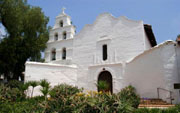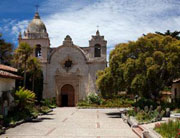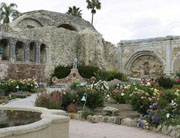-
(单词翻译:双击或拖选)
EXPLORATIONS - Visiting the Beautiful Missions2 Along California’s Coast
FAITH LAPIDUS: I’m Faith Lapidus.
STEVE EMBER: And I’m Steve Ember with EXPLORATIONS in VOA Special English. Today, we tell about the first attempts to settle what is now the western state of California. These attempts began with Spanish settlers who built twenty-one Catholic3 churches called missions. Our report is about those churches -- the missions of California.
(MUSIC)
FAITH LAPIDUS: Our story begins in seventeen sixty-eight in Madrid, Spain. The king of Spain, Charles the Third, had recently received reports that worried him. The reports said Russian explorers were in the northern part of the territory called California. Spain had claimed most of that area more than two hundred years earlier. But Spain had no settlements in California. King Charles knew if the Russians began to settle the area, Spain might lose control of California forever.
STEVE EMBER: King Charles decided4 the best way to keep the Spanish claim to California was to build settlements there. California had good harbors5 for Spanish ships, good weather and good farmland.
 |
| Mission1 San Diego de Alcala |
King Charles decided to order the creation6 of a series of small farming communities along the Pacific Ocean coast of California. The settlements would provide trade and grow into larger cities. Spanish citizens might want to settle there. Then the Spanish claim to California would be safe.
FAITH LAPIDUS: But there was no one on the coast of California to begin the work. King Charles and his advisors7 decided that the farming settlements would begin with churches called missions. Missions were places where Roman Catholic religious leaders converted8 people to the Christian9 religion. They taught the religion to people who wanted to become members of the church.
King Charles decided Roman Catholic priests11 would build the missions and settlements with the help of Native American Indians. The priests would teach the native people the Christian religion, the Spanish language and how to farm.
A religious group within the Catholic Church called the Franciscans would build the settlements. The Franciscans chose a young priest10 named Junipero Serra to begin the work.
STEVE EMBER: Many history experts say the Spanish government and the Catholic Church could not have chosen a better person for the task than Junipero Serra.
Junipero Serra was born in seventeen thirteen on the island of Mallorca, Spain. After he became a Franciscan priest, he taught at a university in Mallorca.
Father Serra had always wanted to be a missionary12. In seventeen forty-nine he sailed to Mexico to begin his life as a missionary. He spent several years studying the languages and customs of native people in Mexico.
In seventeen sixty-eight he was given the job of building the first of the California missions near the present day city of San Diego.
(MUSIC)
 |
| A historic13 picture of San Diego de Alcala |
FAITH LAPIDUS: Mission San Diego de Alcala began on July sixteenth, seventeen sixty-nine. But before the mission was completed, Father Serra decided to move it. He did not like the way Spanish soldiers mistreated the Native Americans. He wanted to keep them separate. He moved the mission to an area that is still called Mission Valley.
The design of Mission San Diego de Alcala was similar to each of the missions that were built later. There was a large church building. A long wall formed a large square to the side and behind the church. Large rooms inside and along the wall served as bedrooms, cooking areas, workshops, and classrooms. Usually, the center of the large square was left open. A garden with flowers was planted there.
STEVE EMBER: Junipero Serra’s plan for the missions along the California coast was simple. Each would be about the same distance from each other. Members of the Franciscan religious group did not ride horses or travel in wagons14. They walked. The missions were built about one day’s long walk from each other. This made it easier to travel, trade goods and share information.
The missions begin with San Diego de Alcala in the south. They end with San Francisco Solano about one thousand fifty kilometers to the north. In time, the road from mission San Diego de Alcala to mission San Francisco Solano was given a name.
The Spanish name is still used today. It is “El Camino Real.” It means the “The Royal Highway” or “The King’s Highway.” Most of that old road is now part of the California highway system. Millions of people use the road every day as they drive from San Diego to San Francisco.
(MUSIC)
FAITH LAPIDUS: Many people have criticized15 the mission system of settlement because it changed the way of life for the Native Americans in California. Critics say many Native Americans were forced to work at the missions.
They say many were forced to become members of the Christian religion. And many were treated badly by Spanish soldiers and died because of mistreatment or disease16.
However, other experts say that Junipero Serra demanded that the priests and soldiers treat the Native Americans with respect. Many of the Native Americans accepted the Christian religion, learned17 to farm and helped the missions become valuable settlements.
Many other Native Americans did not. Some did not want to change the way they lived so they moved away from the missions. Many Native Americans believed they would be forced into a new way of life. In seventeen seventy-six, a group of Indians attacked the San Diego mission and burned it. Eight months later, the mission was rebuilt where it still stands today.
 |
| Mission San Carlos Borromeo de Carmelo where Junipero Serra was buried |
STEVE EMBER: King Charles’s plan was a success. Settlements grew from the missions along the California coast. Some of those along El Camino Real became major cities -- San Diego, Los Angeles, Santa Barbara, San Jose, and San Francisco, to name only a few.
Junipero Serra was responsible for building nine of the missions. One of these was Mission San Carlos Borromeo del Rio Carmelo in the present city of Carmel.
It became his headquarters18 and the headquarters for all of the California missions. In seventeen eighty-four, Junipero Serra died of tuberculosis19 at mission San Carlos. He was buried in the floor of the Mission San Carlos Church.
(MUSIC)
FAITH LAPIDUS: The missions of California faced difficult times during the eighteen hundreds. In eighteen twenty-two, California became part of Mexico, which had just won its independence from Spain. But the Mexican government could not pay the cost of keeping the missions.
In eighteen thirty-four, the Mexican government sold much of the mission land and some of the buildings. Several missions remained part of the communities they helped to build. But many became little more than ruins. Some of the land and the missions were returned to the Catholic Church.
In the eighteen forties, Mexico had trouble controlling the American settlers in California. In eighteen forty-six, the settlers declared California a republic. Less than two years later, the United States gained control of California during the Mexican War.
During this period, the Catholic Church tried to keep control of the missions. They were only partly successful. However, in eighteen sixty-three President Abraham Lincoln signed a law that said all twenty-one missions in California would be returned to the Catholic Church. They have remained so ever since.
STEVE EMBER: Today, the people of California consider the missions a treasure. Eighteen of the twenty-one are still active Catholic churches.
All of the missions are museums that teach the early history of California. Many visitors come to the missions to see the beautiful buildings. Several of the missions have become famous. One example is the Mission San Juan Capistrano. It was planned and built by Junipero Serra.
 |
| Mission San Juan Capistrano |
Each year, on the same day, at almost the same hour, thousands of birds called swallows return to the mission. They return from their winter homes thousands of kilometers to the south. The swallows arrive on March nineteenth. They build nests and raise their young in the old mission. They leave on October twenty-third.
One story says the birds have been late only once because of a storm at sea. Everyone agrees that Junipero Serra would have loved the beautiful swallows of Capistrano.
(MUSIC: “When The Swallows Come Back to Capistrano”)
FAITH LAPIDUS: This program was written by Paul Thompson. It was produced by Mario Ritter. I’m Faith Lapidus.
STEVE EMBER: And I’m Steve Ember. Join us again next week for Explorations in VOA Special English.
 收听单词发音
收听单词发音
1
mission

|
|
| n.使命,任务,天职;代表团,使团 | |
参考例句: |
|
|
|
2
missions

|
|
| n.代表团( mission的名词复数 );使命;官方使命;布道所 | |
参考例句: |
|
|
|
3
catholic

|
|
| adj.天主教的;n.天主教徒 | |
参考例句: |
|
|
|
4
decided

|
|
| adj.决定了的,坚决的;明显的,明确的 | |
参考例句: |
|
|
|
5
harbors

|
|
| n.海港( harbor的名词复数 );海湾;避难所;躲藏处 | |
参考例句: |
|
|
|
6
creation

|
|
| n.创造,创造的作品,产物,宇宙,天地万物 | |
参考例句: |
|
|
|
7
advisors

|
|
| n.顾问,劝告者( advisor的名词复数 );(指导大学新生学科问题等的)指导教授 | |
参考例句: |
|
|
|
8
converted

|
|
| adj.更换信仰的,修改的v.(使)转变( convert的过去式和过去分词 );(使)转化;皈依;改变(信仰) | |
参考例句: |
|
|
|
9
Christian

|
|
| adj.基督教徒的;n.基督教徒 | |
参考例句: |
|
|
|
10
priest

|
|
| n.神父,牧师,司铎,司祭,领导者,神甫;vt.使成为神职人员 | |
参考例句: |
|
|
|
11
priests

|
|
| n.(基督教和罗马天主教的)神父( priest的名词复数 );牧师;(非基督教会的)教士;祭司 | |
参考例句: |
|
|
|
12
missionary

|
|
| adj.教会的,传教(士)的;n.传教士 | |
参考例句: |
|
|
|
13
historic

|
|
| adj.历史上著名的,具有历史意义的 | |
参考例句: |
|
|
|
14
wagons

|
|
| n.四轮的运货马车( wagon的名词复数 );铁路货车;小手推车 | |
参考例句: |
|
|
|
15
criticized

|
|
| vt.批评(criticize的过去式)v.评论,批评( criticize的过去式和过去分词 ) | |
参考例句: |
|
|
|
16
disease

|
|
| n.疾病,弊端 | |
参考例句: |
|
|
|
17
learned

|
|
| adj.有学问的,博学的;learn的过去式和过去分词 | |
参考例句: |
|
|
|
18
headquarters

|
|
| n.司令部,指挥部;总部,总店 | |
参考例句: |
|
|
|
19
tuberculosis

|
|
| n.结核病,肺结核 | |
参考例句: |
|
|
|















